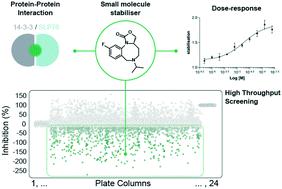当前位置:
X-MOL 学术
›
RSC Med. Chem.
›
论文详情
Our official English website, www.x-mol.net, welcomes your
feedback! (Note: you will need to create a separate account there.)
Identification of molecular glues of the SLP76/14-3-3 protein–protein interaction
RSC Medicinal Chemistry ( IF 4.1 ) Pub Date : 2021-08-02 , DOI: 10.1039/d1md00172h Lorenzo Soini 1, 2 , Martin Redhead 3 , Marta Westwood 4 , Seppe Leysen 5 , Jeremy Davis 2 , Christian Ottmann 1
RSC Medicinal Chemistry ( IF 4.1 ) Pub Date : 2021-08-02 , DOI: 10.1039/d1md00172h Lorenzo Soini 1, 2 , Martin Redhead 3 , Marta Westwood 4 , Seppe Leysen 5 , Jeremy Davis 2 , Christian Ottmann 1
Affiliation

|
The stabilisation of protein–protein interactions (PPIs) through molecular glues is a novel and promising approach in drug discovery. In stark contrast to research in protein–protein inhibition the field of stabilisation remains underdeveloped with comparatively few examples of small-molecule stabilisers of PPIs reported to date. At the same time identifying molecular glues has received recent sustained interest, especially in the fields of targeted protein degradation and 14-3-3 PPIs. The hub-protein 14-3-3 has a broad interactome with more than 500 known protein partners which presents a great opportunity for therapeutic intervention. In this study we have developed an HTRF assay suitable for HTS of the 14-3-3/SLP76 PPI and have completed a proof of concept screen against a chemically diverse library of 20 K molecules. The adaptor protein SLP76 has been reported to interact with 14-3-3 proteins downstream of the TCR playing an important role in mediating its own proteasomal degradation. We believe that stabilisation of this PPI could be exploited to potentiate degradation of SLP76 and therefore inhibit TCR signalling. This would represent an interesting alternative to other approaches in the field of targeted protein degradation. Here we disclose 16 novel stabilisers of the 14-3-3/SLP76 PPI across multiple different chemotypes. Based on the early results presented here we would recommend this approach to find molecular glues with broad applicability in the field of 14-3-3 PPIs.
中文翻译:

SLP76/14-3-3 蛋白-蛋白相互作用分子胶的鉴定
通过分子胶稳定蛋白质 - 蛋白质相互作用(PPI)是药物发现中一种新颖且有前景的方法。与蛋白质-蛋白质抑制研究形成鲜明对比的是,稳定领域仍然不发达,迄今为止报道的 PPI 小分子稳定剂的例子相对较少。与此同时,分子胶的识别最近受到了持续的关注,特别是在靶向蛋白质降解和 14-3-3 PPI 领域。枢纽蛋白 14-3-3 与 500 多种已知蛋白质伙伴具有广泛的相互作用组,这为治疗干预提供了绝佳的机会。在这项研究中,我们开发了一种适用于 14-3-3/SLP76 PPI 的 HTS 的 HTRF 检测,并完成了针对 20 K 分子的化学多样化文库的概念验证筛选。据报道,接头蛋白 SLP76 与 TCR 下游的 14-3-3 蛋白相互作用,在介导其自身的蛋白酶体降解中起重要作用。我们相信可以利用这种 PPI 的稳定性来加强 SLP76 的降解,从而抑制 TCR 信号传导。这将代表靶向蛋白质降解领域其他方法的有趣替代方案。在这里,我们公开了 16 种新型 14-3-3/SLP76 PPI 稳定剂,涵盖多种不同的化学类型。基于此处提供的早期结果,我们建议采用这种方法来寻找在 14-3-3 PPI 领域具有广泛适用性的分子胶。我们相信可以利用这种 PPI 的稳定性来加强 SLP76 的降解,从而抑制 TCR 信号传导。这将代表靶向蛋白质降解领域其他方法的有趣替代方案。在这里,我们公开了 16 种新型 14-3-3/SLP76 PPI 稳定剂,涵盖多种不同的化学类型。基于此处提供的早期结果,我们建议采用这种方法来寻找在 14-3-3 PPI 领域具有广泛适用性的分子胶。我们相信可以利用这种 PPI 的稳定性来加强 SLP76 的降解,从而抑制 TCR 信号传导。这将代表靶向蛋白质降解领域其他方法的有趣替代方案。在这里,我们公开了 16 种新型 14-3-3/SLP76 PPI 稳定剂,涵盖多种不同的化学类型。基于此处提供的早期结果,我们建议采用这种方法来寻找在 14-3-3 PPI 领域具有广泛适用性的分子胶。
更新日期:2021-08-02
中文翻译:

SLP76/14-3-3 蛋白-蛋白相互作用分子胶的鉴定
通过分子胶稳定蛋白质 - 蛋白质相互作用(PPI)是药物发现中一种新颖且有前景的方法。与蛋白质-蛋白质抑制研究形成鲜明对比的是,稳定领域仍然不发达,迄今为止报道的 PPI 小分子稳定剂的例子相对较少。与此同时,分子胶的识别最近受到了持续的关注,特别是在靶向蛋白质降解和 14-3-3 PPI 领域。枢纽蛋白 14-3-3 与 500 多种已知蛋白质伙伴具有广泛的相互作用组,这为治疗干预提供了绝佳的机会。在这项研究中,我们开发了一种适用于 14-3-3/SLP76 PPI 的 HTS 的 HTRF 检测,并完成了针对 20 K 分子的化学多样化文库的概念验证筛选。据报道,接头蛋白 SLP76 与 TCR 下游的 14-3-3 蛋白相互作用,在介导其自身的蛋白酶体降解中起重要作用。我们相信可以利用这种 PPI 的稳定性来加强 SLP76 的降解,从而抑制 TCR 信号传导。这将代表靶向蛋白质降解领域其他方法的有趣替代方案。在这里,我们公开了 16 种新型 14-3-3/SLP76 PPI 稳定剂,涵盖多种不同的化学类型。基于此处提供的早期结果,我们建议采用这种方法来寻找在 14-3-3 PPI 领域具有广泛适用性的分子胶。我们相信可以利用这种 PPI 的稳定性来加强 SLP76 的降解,从而抑制 TCR 信号传导。这将代表靶向蛋白质降解领域其他方法的有趣替代方案。在这里,我们公开了 16 种新型 14-3-3/SLP76 PPI 稳定剂,涵盖多种不同的化学类型。基于此处提供的早期结果,我们建议采用这种方法来寻找在 14-3-3 PPI 领域具有广泛适用性的分子胶。我们相信可以利用这种 PPI 的稳定性来加强 SLP76 的降解,从而抑制 TCR 信号传导。这将代表靶向蛋白质降解领域其他方法的有趣替代方案。在这里,我们公开了 16 种新型 14-3-3/SLP76 PPI 稳定剂,涵盖多种不同的化学类型。基于此处提供的早期结果,我们建议采用这种方法来寻找在 14-3-3 PPI 领域具有广泛适用性的分子胶。











































 京公网安备 11010802027423号
京公网安备 11010802027423号